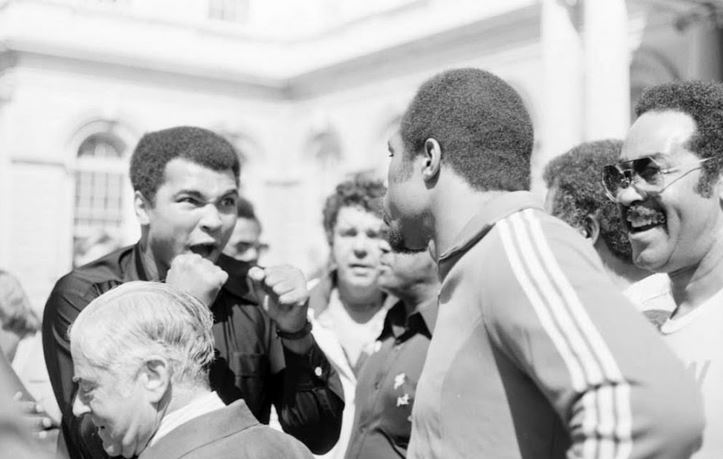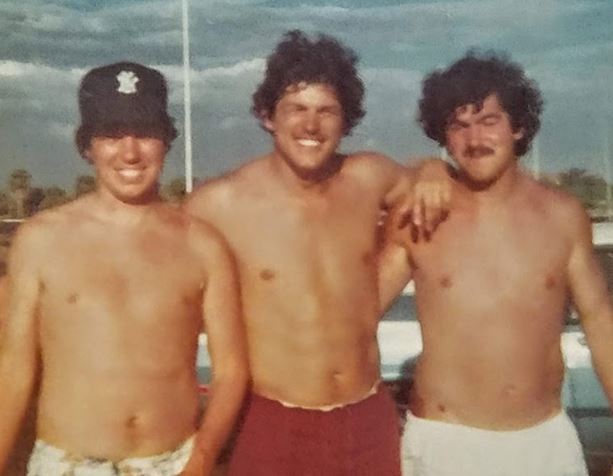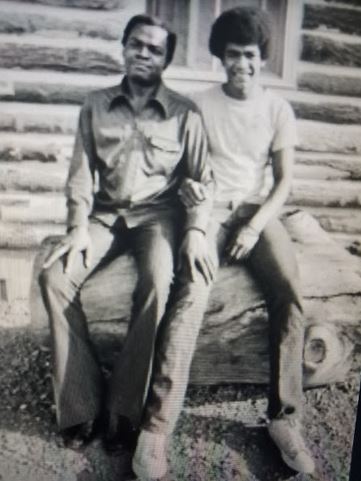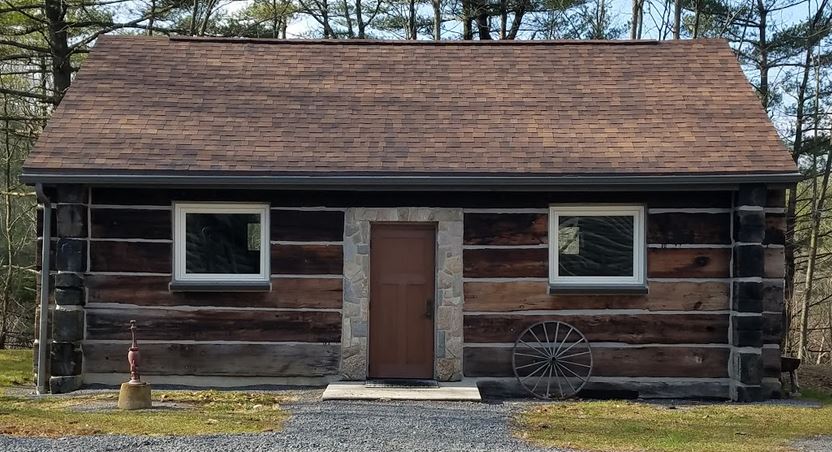By Tom Ducatte
Bored with another eastern Pennsylvania winter, even a mild one, I called on a few friends this past February and we piled into our old Dodge Ram pickup and headed 60 miles southwest of Stroudsburg to Deer Lake, PA, to tour Muhammad Ali’s former training camp, “Fighter’s Heaven”. The camp is being restored by Mike Madden, a California real estate developer and also the son of Hall of Fame Oakland Raiders coach and great NFL announcer/analyst John Madden. Deer Lake historically was a resort town that served the anthracite coal barons from Pottsville in the early 20th century. I had imagined the camp in an open field but upon arriving I realized I was not even close. The camp was built on Sculps Hill Road, an appropriate name given it is sculptured out of a rocky forested side of a hill. Ali built the camp there in 1972 to escape the Miami hubbub, a longtime training location. Ali loved Deer Lake, the place where he trained for the “Thrilla in Manilla” with Joe Frazier and his upset victory over George Foreman in the “Rumble in the Jungle”.
We caught a break with the weather and arrived to sunny skies and the caretaker Mike Stefanek, a retired educator and Marian Catholic High School boys varsity basketball coach, invited us to explore the grounds including Ali’s cabin, the camp kitchen, the training gym, Ali’s small mosque, and the boulders on which his father had painted the names of past boxing heavyweight world champions. The restored Fighter’s Heaven camp buildings are filled with memorabilia, photographs and videos offering visitors reminders of Ali the boxer and moreover why he became one of the most recognized people in the world. Madden’s restoration also offers young people the opportunity to learn of Ali’s contributions in and out of the ring.
Visiting Deer Lake that day was more thought provoking than I thought it would be. It reminded me, very clearly, of a trip to Show Low, Arizona, 44 years earlier when I didn’t know as much as I know now. I’ve been fascinated with this great American figure and have read hundreds of articles about Muhammad Ali along with numerous books and even watched a few movies. However, the difference between those stories and mine is that my older brother Jim and I experienced this one.
“You’re an Indian aren’t you?” Those were the words Muhammad Ali’s motivator/trainer Drew ‘Bundini’ Brown spoke to me in August of 1976. The night before this encounter, Jim and I had been hanging out at his trailer with a few friends in southwest Flagstaff, Arizona. Both of us were finishing our studies at Northern Arizona University. Actually, including brother Mike, we were three brothers from Plattsburgh, New York, located on the shores of Lake Champlain attending NAU. All three of us found the programs we wanted and agreed that Flagstaff was the place to be with its beautiful setting. I had read an article in The Arizona Republic newspaper earlier that day about Muhammad Ali’s training schedule in a small southeast Arizona town called Show Low. Some time that evening I suggested to Jim that we go watch Ali train for his third and deciding fight against Ken Norton at Yankee Stadium scheduled for September 28, 1976.

Jim, always up for adventure, was quick to reply, “Let’s go”. Shortly after midnight we took off in my girlfriend’s old red Volkswagen bug and headed out on Route 66 for the 138 mile trip. One of the advantages of going to a college like NAU was its central location in the state. To the north you could experience the Grand Canyon and the Hart Prairie Preserve. To the south hike Oak Creek Canyon or watch professional baseball’s spring training in Phoenix and Tucson. To the west, the Colorado River was always another option. That night, though, we were heading southeast to the beautiful White Mountains. Our younger brother Mike, who had janitorial duties at Judge Woo’s Pizzeria that night, still reminds us that we should have waited for him to punch out of work. When Mike and I were little kids, I would pretend I was Ali and he was some hopeless opponent. I would proceed to pummel him on a regular basis until he said the magic words, “Please Ali, spare me.” Jim and I still feel bad about leaving Mike behind. But that’s the only thing we feel bad about.
We rolled into a rest stop about 3 am on the outskirts of Show Low to catch a nap until daylight. Show Low is located in the White Mountains with an elevation of 6,345 feet with a population today of approximately 11,000 people. That sunny morning when we arrived in town a gas station attendant mentioned Ali might be staying at a motel/restaurant called the Maxwell House. It was still early so we also stopped at a grocery store, picked up some hot dogs and buns and charcoal, and in short order came across the Show Low City Park where we found grills we could use.
Soon after it was time for us to play detective and check out the Maxwell House Motel restaurant whose manager explained Ali’s entourage was renting five rooms out back. According to sports journalist Jerry Izenberg, when Ali first arrived at the Maxwell House he insisted on seeing Mr. Maxwell. He was told there was no Mr. Maxwell there. Ali then asked for the current manager. “Mr. Maxwell, I am about to make your motel more famouser [sic] than your coffee,” and then went on, for the most part, to keep his word.
The motel manager also shared that on this day the training at the Show Low airport was open only to the press. He must have noticed the disbelief on my face and suggested we might talk to someone from the Ali camp. Devastated, I mumbled to my brother, “What do we do now?” Maybe you could knock on one of the doors Jim suggested. I replied, “You can go knock on the door. I’m not.” No way I was going to do that. We were standing outside the Maxwell House restaurant looking down at the motel and realizing we were going to have to suck it up and get brave. Going back without watching the training session, with not even trying to get in, was not an option. Show Low was named after two mountain men involved in a fight in 1875 that decided which one had to vacate the premises by a cut of the cards. “Show low” ordered Clark to Cooley. Cooley pulled out the deuce of clubs. Clark skedaddled on out. I lost as well with Jim in a mental game of “chicken” and headed down the hill.

By this time people were moving around, walking in and out of various rooms. I recall Ali’s staff carrying boxes of fruit into their different rooms. At that time Dick Gregory, the popular comedian and civil rights activist, was trying to help Ali with his diet and nutrition. Again, Jerry Izenberg had written that Ali hated Gregory’s health drink concoctions and would dump them in the toilet whenever Gregory wasn’t around. I continued to walk down the hill toward the five rooms.
Ali took second to none of my boyhood heroes. Move aside Brooks Robinson, Joe Namath, Dave Debusschere, Ali was the man. Five motel rooms. I had a 20% chance of knocking on Ali’s door. I was about to play boxing’s version of the Price is Right. Probably more like Russian roulette because if Ali had answered the door it would have been his first TKO knockout by just looking at someone. I can hear Ali now, “Angelo, (Dundee, head trainer) get some smelling salts for this poor boy.” I knocked on the middle of five doors and said to myself here we go.
A stoic ‘Bundini’ Brown answered the door. The man I had seen in Ali’s corner for many of his fights stood before me. I stammered, ”Mr. Bundini, my name is Tom Ducatte and my brother and I are students at Northern Arizona University. We’ve traveled three hours to get here to watch Ali train and we just found out that the training session was only open to the press today. Is there any chance you could help us get into today’s workout?”

Bundini, a stocky black man, then 47 years of age, with a long scar running down his cheek questioned, ”You’re an Indian aren’t you?” My first thought was if it helps me get into the training session, then yes. I went with the truth and said, “No.” Now and then I have wondered why he asked me that question.
What a greeting from not just the long time corner man and assistant trainer, but Ali’s hype man and close friend over the years as well. In King of the World, David Remnick explained Bundini was born Drew Brown, more or less raised himself in rural Florida and lied about his age to join the navy at 13 as a mess boy. He had seen a lot in his lifetime. Before Ali, Brown had traveled the world and during a particular stop in Lebanon was given the name Bundini by a Lebanese family he came to know well. He never knew the meaning of the name, but it stayed. Despite the spelling, he pronounced the name, “Bo-dini,” and Ali did the same.
Bundini spent seven years in the great Sugar Ray Robinson’s corner. According to Edwin Shrake’s 1971 Sports Illustrated article, “Bundini: Svengali In Ali’s Corner,” Robinson’s brother-in-law Bob Nelson had introduced Bundini to Ali, claiming, “You think you can talk, you must hear this man.” Bundini believed that champion fighters are born not made. He wanted Ali to stick to the style that best suited his boxing style and as a reminder to Ali he came up with the saying, “Float like a butterfly, sting like a bee, the hands can’t hit what the eyes can’t see”. Larry Holmes, former heavyweight champion and Ali’s Deer Lake sparring partner stated that Bundini was critical to Ali’s boxing success. Former champ George Foreman repeated Holmes’ praise about Bundini. Some hip-hop and rap artists contend Ali and Bundini were two of the first to influence their art form with rhyming and a brash attitude predicting when the champ would knock out his opponent.
Bundini didn’t have any play on words with me that day, however. The only rapping that day was my rapping on the motel door.
“Follow me when I leave.” Five words. That was the extent of Bundini’s side of the conversation.
About 20 minutes later he came roaring out from behind the motel in a Pontiac Bonneville or a similar model, kicking up dust from the dirt driveway. “Now you see me, now you don’t.” He looked like a man driving with a purpose to get somewhere fast. I shouted to Jim, “He’s flying.” It was about two miles west onto Deuce of Clubs Street which blended with Route 60 to the training facility at the airport. We couldn’t keep up and eventually lost sight of him. “I think he tried to lose us.” Amazingly we caught up to Bundini at the entrance where a guard was checking cars. Bundini’s new buddy was hanging out the VW car window waving frantically from the passenger seat like a second grader trying to get his teacher’s attention. The guard waved us through and never hesitating told us where to park. Bundini had taken care of us.

Ali was training in a quonset hut, a structure made of prefabricated galvanized steel having a semicircular cross section. Normally reserved to store planes, it became a training site while the heavyweight champion of the world was in town. Quite a few people about four deep surrounded the ring. It seemed his trainers weren’t overly happy with Ali’s effort that day. Maybe it had something to do with being in the hot Arizona sun in the middle of August or maybe at the age of 34 he was beginning to show signs of lack of focus and the monotony of many years of training.
When we settled in and found a spot, Ali was sparring with the ex-heavyweight champion Jimmy Ellis, who had won the 1968 WBA heavyweight championship by defeating Jerry Quarry and eventually losing to Joe Frazier in 1970. Angelo Dundee was there as well.
One of the memories of that training day in Show Low that has stayed with me all these years is Muhammad Ali’s aura or command. I stood ringside saying to myself, “Please don’t look at me.” Such a presence and energy. Several minutes into the session a black limousine pulled up parallel to the hanger entrance. As Veronica, Ali’s wife, opened the car door to watch him train, Ali stopped his workout and waved to the crowd to make space for the car. A local Barney Fife cop made sure the clearance stayed open for as long as Ali wanted. Eventually after about 10 minutes the limo pulled away. I took a half step back into the open space and the older cop directed me to get back since Ali had not given permission for the space to close. Ali had parted the Red Sea much like Moses and he was the only one who could close it. Remnick explained in his book that Bundini always called God “Shorty.” Ali wasn’t Shorty, but to me he must have been somehow closely related. You had to witness this man in person.
After the hour and a half workout we grabbed lunch at a local eatery. Ali was beloved in Show Low in the short time he was encamped there. He was constantly interacting with people in the community, especially the children. Leaving Show Low that afternoon we drove down Main Street heading for Flagstaff. Our day with Ali was not over, however. We came upon a bridge where Ali was walking toward our car engaged in conversation with a young mother and her little girl. We slowed down and I suggested to Jim that I get out and kiddingly mimic the “Rope a Dope” that Ali had performed so successfully in 1974 against George Foreman. Even back then I had enough common sense to think it but not do it. Driving back to Flagstaff I looked over at my older brother and we gave each other a hand slap for a day that we knew we would always remember
Ali would win that fight with a unanimous decision. Some time later he admitted that Norton probably won the fight due to Norton’s style that confused him in all three fights.
Years later I would have the opportunity to meet Angelo Dundee in 1995 after his boxer lost a match at the University of New Mexico. He graciously signed the fight poster as he walked out from a devastating loss. “Yes sir, no problem”. What a class act he was.
We went to Show Low when I was 23 and 44 years later and now 67 years young I journeyed to Deer Lake. I cannot say which day was more exciting than the other, but I knew I had visited two very special places. Someone might suggest, “But you saw Ali at Show Low.” Yes, but the trip to Deer Lake might be second only because it lacked Ali’s physical presence. In the name of Shorty, I can vouch that his spirit is there at Deer Lake.
All of this began with two NAU students and a wish to see possibly the greatest fighter of all time. It became real with a knock on a door and a colorful trainer who helped make it all happen. Thank you, Bundini.